The bond market’s reaction to the inflationary environment, to fears of a lax Fed, and to a Mississippi River of new debt.
By Wolf Richter for WOLF STREET.
The 30-year Treasury yield rose by 10 basis points on Friday to 4.96%, despite a 30-year Treasury auction on Thursday that was described as “solid” and “strong,” where the government sold $22 billion of 30-year bonds at a yield of 4.89%.
So far in July, the 30-year yield has risen by 18 basis points. It is now 63 basis points above the effective federal funds rate (EFFR), which the Fed targets with its monetary policy rates (blue in the chart).
This increase in yield came despite the government’s assurances that it would only slowly replenish its checking account, the Treasury General Account – which had been partially drained during the debt-ceiling period – by taking it easy on issuance of long-term notes and bonds, and by slowly increasing the issuance of short-term T-bills, all in order to defuse the pressures around long-term yields, while short-term yields are bookended by the Fed’s policy rates and expectations of those policy rates over the near term.
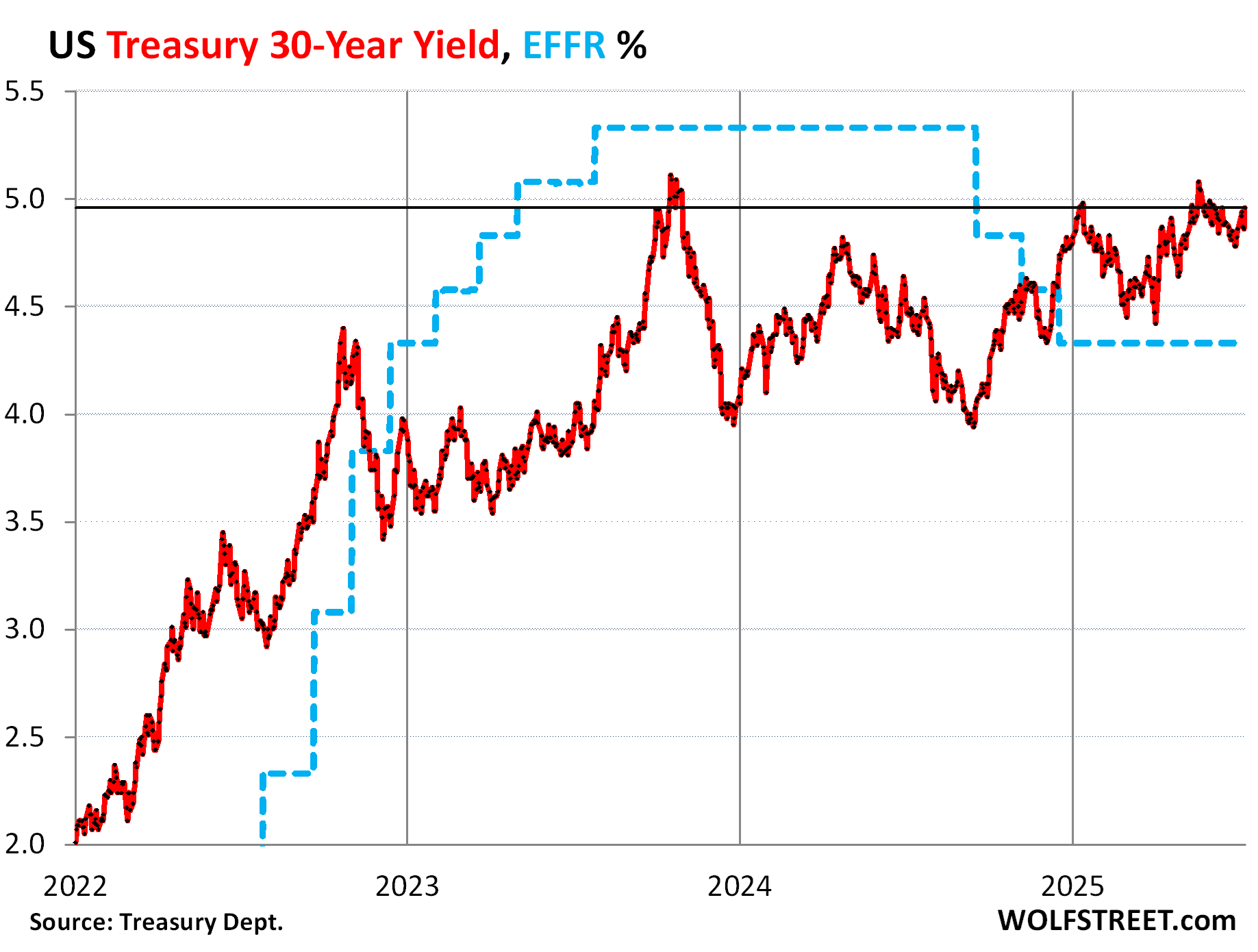
So, since the Fed cut by 100 basis points starting in September (dotted blue line), the 30-year yield (red line) has risen by 102 basis points!
The 30-year yield is a thermometer of the bond market’s current fears about:
- Inflation over the long term
- A lackadaisical Fed in face of this inflation
- And a Mississippi River of new Treasury debt flowing into the market.
That the 30-year yield is back near 5% amid all these efforts to keep it from going there is quite something.
This reaction – rate cuts of 100 basis points lead to a 102-basis-point increase of the 30-year yield – raises the secret question: How many more rate cuts would it take to drive the 30-year yield to 6%?
Cutting policy rates in an inflationary environment has turned out to be a very tricky thing. Bessent may have had this type of conversation with Trump, but it likely went in one ear and out the other.
The yield curve: bond anxiety.
The chart below shows the yield curve of Treasury yields across the maturity spectrum, from 1 month to 30 years, on three key dates:
- Red: Friday, July 11, 2025.
- Gold: January 10, 2025, just before the Fed officially pivoted to wait-and-see.
- Blue: September 16, 2024, just before the Fed’s rate cuts started.
With rate cuts still on ice, short-term yields up to six months haven’t budged much and remain glued to the EFFR of 4.33%. But rate-cut expectations have pushed down yields over six months and into the five-year range.
What is pushing up long-term yields are the other factors: inflation expectations over the long-term, concerns over a lackadaisical Fed in face of this inflation, and a Mississippi River of supply flowing into the market that has to be absorbed by additional buyers that may have to be enticed with higher yields.
So, at the long end, the yield curve has steepened. The 10-year yield is higher than all yields shorter than 10 years:
- Between 8-16 basis points higher than 1-6-month yields
- About 52 basis points higher than the 2-year yield
- About 56 basis points higher than the 3-year yield
And the 30-year yield is right back where it had been on January 10, just a hair below 5%.
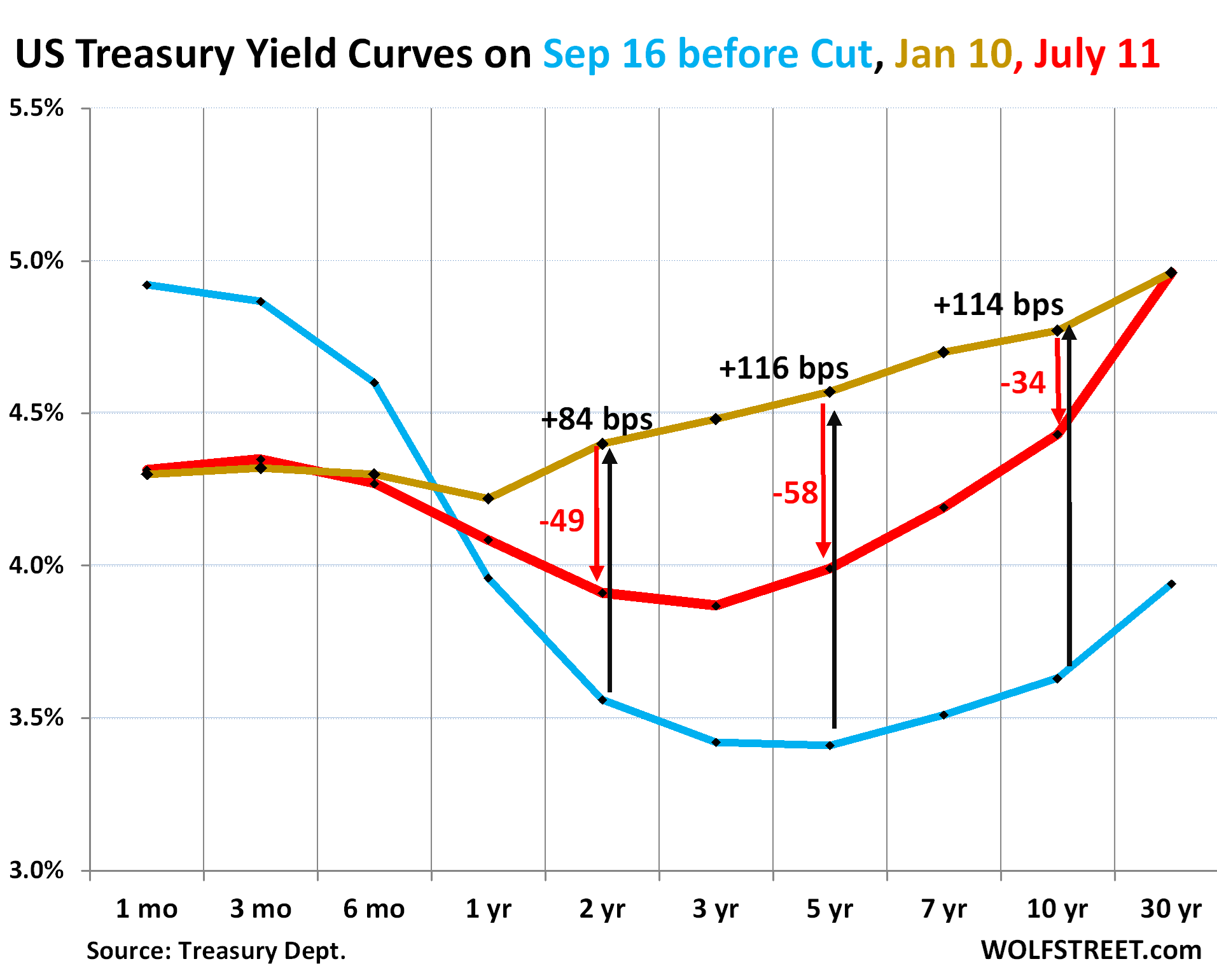
The 10-year Treasury yield has been hovering near the EFFR for months. But it too has risen: by 8 basis points on Friday, by 19 basis points so far in July, and by 80 basis points since the eve of the Fed’s rate cuts.
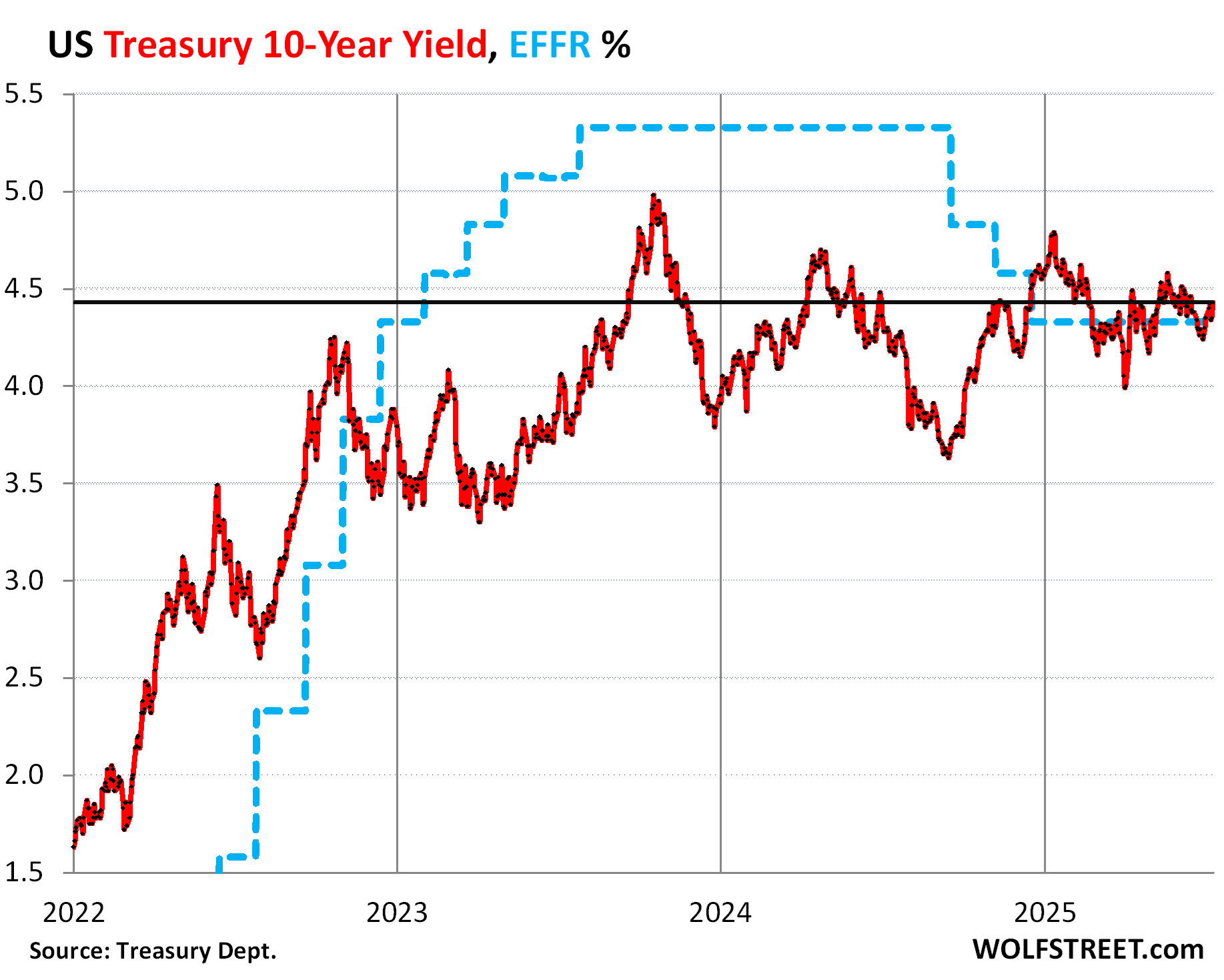
The six-month yield, which is a good indication of market expectations for cuts within 2-3 months, has been glued to the underside of the EFFR and is thereby not yet predicting rate cuts within 2 to 3 months.
The FOMC’s September meeting, with a rate decision to be announced on September 17, is just on or beyond the outer edge of the 6-month yield’s vision. So going forward, we’ll watch the 6-month yield for indications of a September rate cut.
But there is now substantial disagreement among the FOMC members about rate cuts. The CPI report next week may shift their rate cut rhetoric into one or the other direction, and the 6-month yield would then begin to react to it.
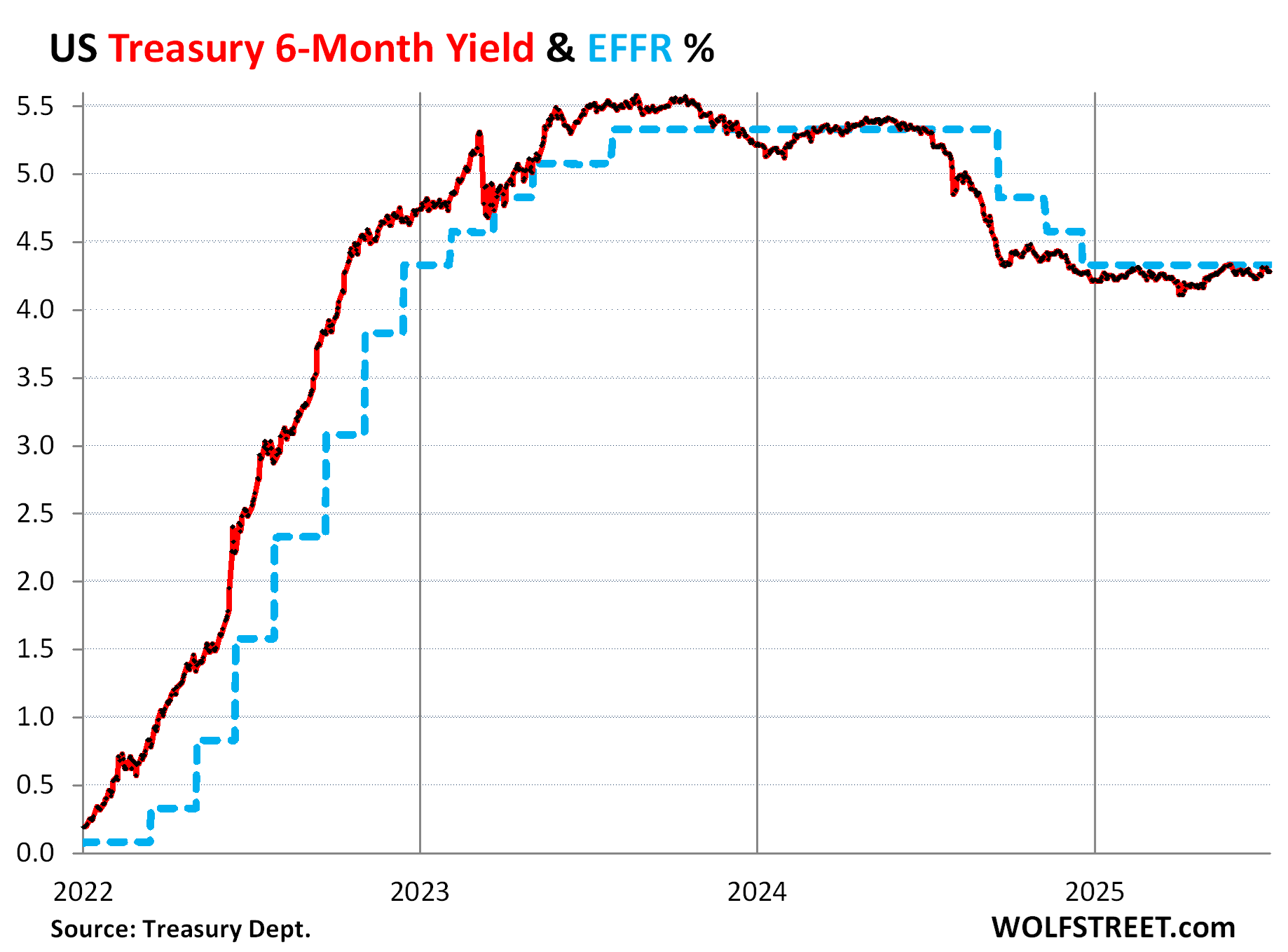
For 30-year fixed mortgage rates, the 10-year yield and the spread matter.
The average 30-year fixed mortgage rate has been above 6% since September 2022 and has stuck fairly closely to either side of 7%.
In the latest reporting week, which does not yet include the rise of the Treasury yields over the past few days, the average 30-year fixed mortgage rate ticked up to 6.72%.
It didn’t drop to 5% until the Fed started QE, including buying trillions of dollars of MBS, from early 2009 on, which helped push down mortgage rates. But the consumer price inflation that broke out in 2021 put an end to it.
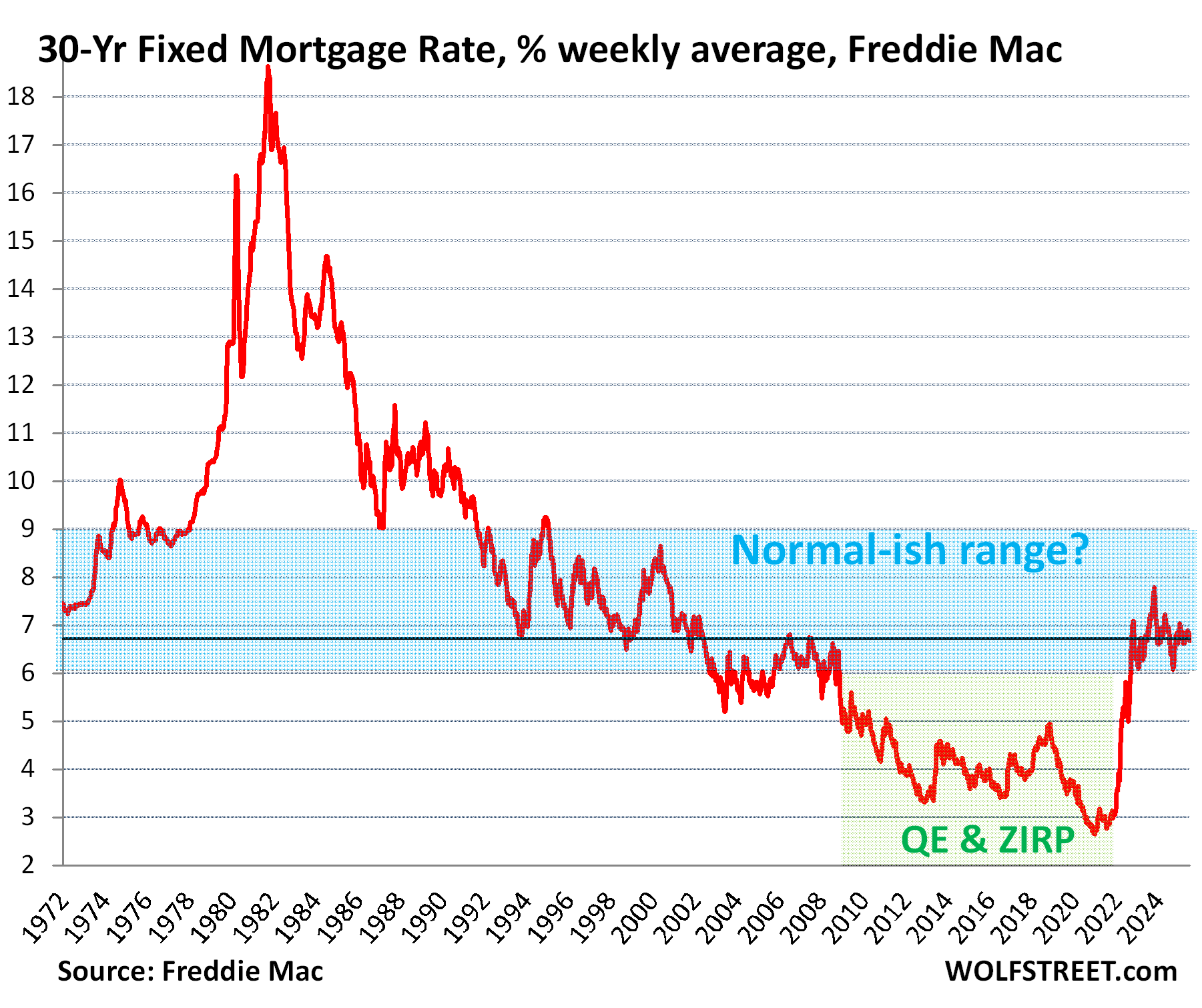
The spread between the average 30-year fixed mortgage rate and the 10-year yield has been fairly wide since the Fed ended QE and thereby stopped buying MBS, and then started QT in the second half of 2022, thereby starting to unload its MBS. It has by now unloaded over $600 billion of its MBS, and has said many times that it wants to get rid of its MBS entirely, and only hold Treasury securities on its balance sheet.
The spread between the weekly average 30-year mortgage rate and the weekly average 10-year Treasury yield was 2.34 percentage points. Over the past four decades, that happened only four times, twice very briefly just before and at the end of the Dotcom Bust, and twice during two panics, when the 10-year yield plunged amid massive QE, and mortgage rates were slower to follow. Now there is no panic, the 10-year yield is near 4.5%, and the Fed is doing QT..
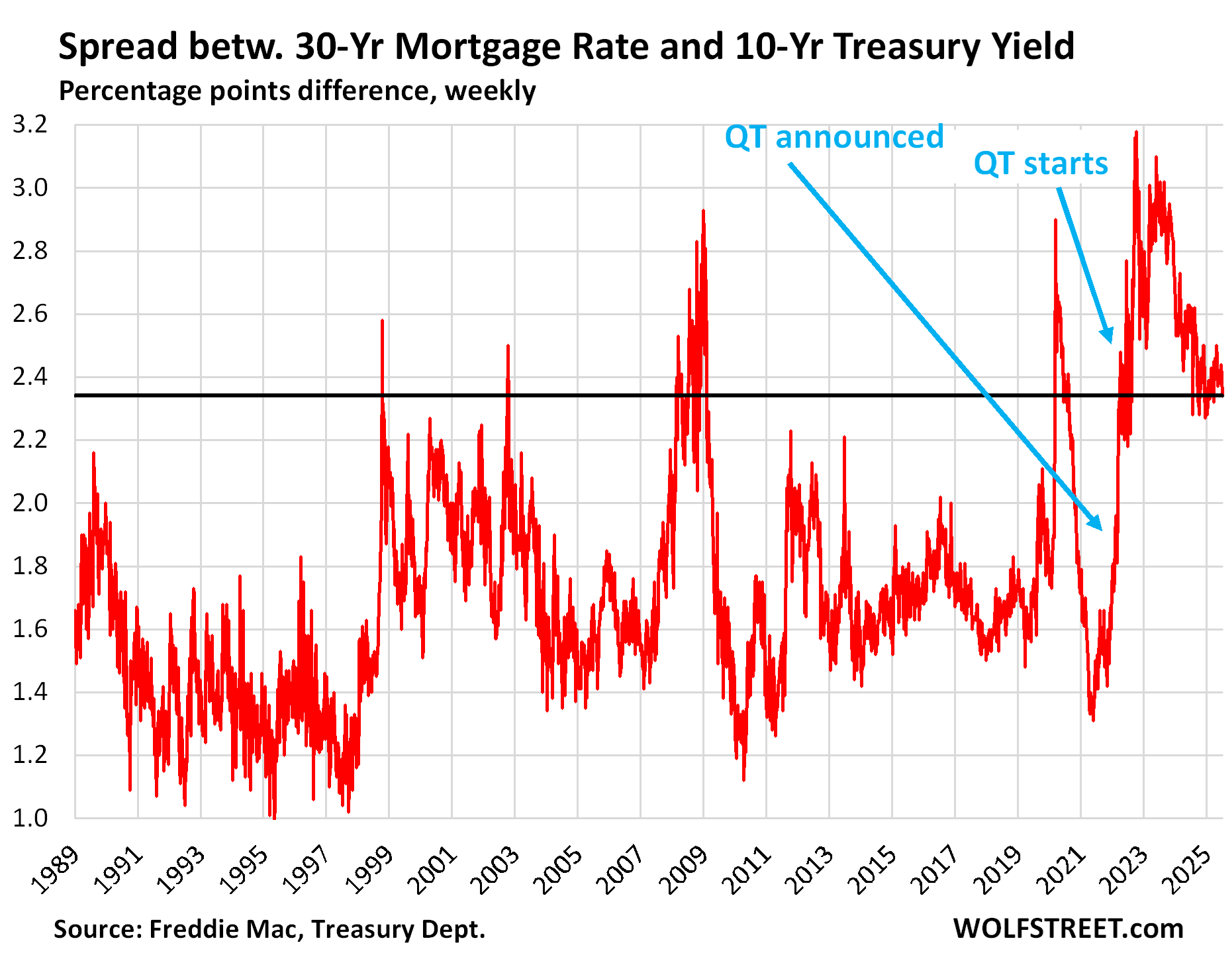
Enjoy reading WOLF STREET and want to support it? You can donate. I appreciate it immensely. Click on the mug to find out how:
![]()


Long term bonds still don’t pay enough. Interest rates are too low which is why capital is flowing to stocks and bitcoin. RIP Treasurys.
Exactly right. Risk assets still the best way to butter your bread. I’d say a relatively risk free 5% is alright if you’re already rich looking for somewhere to park your money. But for the rest of us treasuries make 0 sense.
Except that it only works if stocks can continue expanding based on multiples. At some point, there will be a change in psychology, and those risk assets will plummet.
Yes, you need high 10-year real-rates of interest. At 1.87 interest rates on 2025-06-01, interest rates yield less than can be found in too many other areas.
The correct measure is to lower FDIC insurance rates, aka, the “taper tantrum” driven from the drop from unlimited transaction accounts to $250,000 limits.
Trump gonna need a super volcker not petty powell
Any Chairman of the Federal Reserve becomes just one of the twelve members of the FOMC which establishes policy interest rates – all of which are short term interest rates.
Bitcoin still hasn’t made a new high priced in euros. It has in yen and Canadian dollars. Capital flows, risk has been back on. However, The USA stock market hasn’t made new highs in any currency but $USD. The ROW haven’t seen new highs in the US stock market once they convert back into their homeland currency!! If the USA has the reserve currency we also have a reserve asset Destination for surplus capital being invested USA equities. When will the ROW bail on their USA assets holdings? When they do Americans won’t be able to keep the risk on party going. Technically, damage was done in the April sell off and the $USD weakness is the only reason we are sitting at all time highs right now, priced in a world currency basket we are 4% below all time highs that were made in Dec 2024.
Cool, rooting for 6% or higher soon, so I can eventually just park most of my money there, despite the short term cut soon and Tbill will be not as attractive. Sure is nice if we don’t go back to any TINA environment and force to buy stock in these ridiculous valuation now.
On the hand, the mortgage spread sure is nice to see, hopefully it will hold. Nothing better than to see that to use it as a STFU to all the genius and RE agents brain deadly repeating cutting short term rates will mean lower mortgage rates..so date that rates now…
Always liked the longtime real estate agents using pictures from their Junior Prom.
I don’t think anything the Fed does right now can reassure the market with the chaotic policies coming from Pres tirade tariff. No one knows what is coming tomorrow and that’s what is showing. The constant undermining of the Fed isn’t helping anything either.
The tariffs brandished by Trump like a sword will not always be there. They are primarily a negotiating tool used by the Donald to get a better deal for his own country. Trump often goes on the offensive when he senses he has the upper hand, and for him America’s wealth and absorption of foreign goods means the U.S. has the firm upper hand.
Trumps tariffs and threats random are disingenuous and thus ineffective ,and other countries know it. To think countries won’t offer a strong response to his nonsensical actions is naive
Personally I think all the hate for Powell and saying he needs to cut rates is PR for his fan base. He’s a real estate guy which means he should understand the bond market, cutting in this environment seems unlikely to lower the 10 year rates or mortgage rates. Cutting isn’t going to fix the demand issues for CRE – with buildings vacant there’s still going to a be a large risk premium built into any refi.
What I think cutting short term rates will do is prop up the stock market and the economy because below 4% (basically 3% after taxes) it makes no sense to have money parked there so instead people will spend or invest in the stock market
“He’s a real estate guy which means he should understand the bond market….”
LOL! He’s a real estate SALES guy. Giant difference.
Does the US $ dropping %18 against the Euro affect bonds?
If anything, it would make them more attractive to euro-based investors, and so they would bid up their price (push down their yields). Some of this is happening for whatever reason, because US Treasuries are immensely popular with EU investors (red line), but not so much with Chinese investors (blue).
Is it a problem for organisations that owned bonds when the dollar was strong?
For new euro investors, the drop in the dollar is an opportunity because those bonds are now cheaper for euro investors.
For euro-investors that have owned these bonds for a while, the drop in the dollar means lower euro-value of those bonds.
This assumes that they’re not hedged.
The same with yields: when yields drop, existing investors make money. When yields rise, existing investors lose money.
But for new investors rising yields (lower price) are more attractive.
Keep it coming! I want the 18% mortgages we’ve heard SO much about. That’s how a generation learns the value of hard work and to pull themselves up by the bootstraps, right?
Bring it on.
I had one. It was not fun, but we got through it.
Similar to AA, we had a mortgage at that rate in 1979,,, but, and it’s a huge butt, the house cost $40K, and with 20% down payments were quite affordable.
Last time I looked, that house sold for $800K, and now valued over a million.
Everyone needs to read this comment over and over again until they understand.
I sure hope so. I’d rather buy an affordable home like the boomers got to in the 70s and 80s that I can make balloon payments against than to pay half a million for a crappy median priced home at a 7% rate.
Literally the greatest leg-up a generation ever received
The reason homes are selling for “half a million” is because BUYERS were eager to pay that much for them — they trampled all over each other to pay that much for a “cappy” home. QUIT BUYING HOMES, let boomers sell their homes to the angles in the sky, and prices will come down. It’s BUYERS who drove up prices, not sellers.
And a large number of people has quit buying homes, so that’s step in the right direction.
Incomes are a LOT higher than they were back then, and they continue to grow, so home prices don’t need to fall back to price levels of the 80s to make sense today, but they do need to fall.
18% mortgages would be fine if a $500k house suddenly became sellable for $200k.
Some group is going to get hurt and some group may benefit.
1969 all over again? Bessent the next Burns?
1969 was a good year as I began my career in oil and doubled my wages.
You mean Powell the new Burns. This guy waited too long to raise rates while at the same time Yellen didn’t change the stance of debt rollover to long term bonds when the 30 year was down.
Now, I am not an economist, but we’re about 50bps out of bounds on the funds rate. Yields are meant to be linear, however the 2 year lags. 30 year resurfaced for many reasons as mentioned above. One particular I’d note would be the paltry 5 billion a month of QT we are doing. Again another Powell disaster. Bessent received a disaster of an issue made by Yellen. Yellen worst treasury secretary in my lifetime.
I think Yellen knew she couldn’t sell the long term debt,and Bessent found that out about April 4
Give Bessent the rest of his term …..
That can’t and won’t be done. Obviously. Bessent is an imbecile.
Not suprised with the misallocation of funds all these years. Expect 10 year at 5% and 30 year at 6% shortly. Debt hasn’t been serviced in a long time and people want more return on investment with debt to GDP at 125%.
The US debt is ALWAYS services all the time. The only question is at what price. It is dangerous for it to be so heavily reliant on short-term rates versus long-term rates as it makes the cost of servicing it much more unpredictable and volatile.
In the past 30 years the USD has lost more than half its value. What you could buy for a $1 in 1995 now costs $2.11. In these circumstances what idiot would buy 30 year bonds paying 5%? The rate should be at least two or three times that to compensate.
A 30-year bond that pays 5% in interest pays $50 a year in interest on a $1,000 bond. Over a period of 30 years, that’s $1,500 in interest. And if you run a bond portfolio, you reinvest the interest in new bonds, the interest on the interest compounds for 30 years, and gains are far larger. If compounded semiannually at 5% for 30 years, you would end up after 30 years with the $1,000 bond, paid off in cash, plus about $3,400 in compounded interest, for a total of $4,400.
TIPS rate is 2.63%. Incredibly low still.
That’s actually pretty good because you also get the inflation protection added to the principal. The inflation protection is based on CPI and changes with CPI.
I like the rule of 72 for quick math to show capital doubling. Divide 72 by 5(% return) and it takes 14.4 years to double your money. Obviously, no inflation adjustments in the simple rule of 72. The Nikkie was under its high mark set in 89/90 for ~3 decades, risk carries risk.
Is there another high volume financial asset that is guaranteed to the same degree as treasuries?
Not any $USD assets — treasuries are called “the risk free rate” for a reason.
They are guaranteed in US dollars. As WR has said many time a sovereign can’t default in its own currency, because it can just print it.
PS: if you are looking for a guarantee of purchasing power that is a different animal.
Well if you watch CNBC, it’s probably Nvidia #!@&*%!!!
A “solid” auction yet an increasing yield. Please correct me if I am wrong.
This, imho, sounds like a contradiction. For a solid auction there should be high demand with prices rising and yields falling.
Also interesting that the Chinese have lost their appetite for US treasuries. Maybe another reason for higher yields.
Andre-
It’s in the by-line: “Mississippi River of new debt.”
“Solid auction” demand is counterbalanced (and then some) by bulge in supply… thus long end prices decline marginally.
This is what “grinding higher” treasury yield market looks like. Expect about 40 years of “two steps forward, one step back” for long bond rates, in keeping with Homer and Sylla’s History of Interest Rates.
Thanks John “Grinding higher”,I like it. The Fed may drop interest rates but the market will ignore it. True rates will reign
Andre, my understanding of what the Fed considers a “solid” auction is one which results in a certain amount (I don’t know the quanta) of bidders left empty-handed — which is to say that the auction is “overbid.” Now, there is some question as to whether or not the structure of the auction itself is designed such that there will always be “overbidding” given that the primary dealers (and no, I don’t know how many of them there are) are REQUIRED by regulation to submit bids.
So presumably if a large enough number of primary dealers are submitting high enough bids, still not all of them will get allocations, resulting simultaneously in higher yields and what the Fed calls a “solid” auction.
If I have not made this clear, please let me know. Also, if I am just outright wrong about the auction process, I also welcome correction — I don’t like to remain ignorant if I can possibly help it.
Everyone does rate cut or increase analysis but they forget the every increasing debt to 40T within a few years will create havoc in markets in ways that you cannot forecast, including servicing this debt with 1T+ mandatory payments, if Democrats get elected in 2028 their policies will accelerate debt, no one wants to increase taxes
If Democrats ever get control of anything again, ALL Republicans will instantly convert from crazed spenders and debt-doesn’t-matter promoters to fiscal hawks, and they will try to block all spending.
Yes. The whole charade is really tiresome to those of us older than 24 who have seen this stupid game time and time again.
Yup
except military and foreign aid.
Re: If Democrats ever get control of anything again
Republicans are acting like they have no re-election concerns — even in the face of polls that show their constituents are not supportive of their legislation.
Is that over confidence, arrogance, ignorance — or a red flag that the republicans won’t cede power?? There is a reckless willingness to redefine the Constitution or rewrite it — which worked well for Putin and other dictators.
The NIMs of large banks typically ranges from 2.5 to 3.5 percent. It’s higher for smaller banks, 3.5 to 4.5%. But with the IOR at 4.4 percent, there’s not much reason for expanding commercial bank credit.
QT, while paying interest on interbank demand deposits at the FED, has heretofore restricted the growth of the money stock. Powell needs to hold his ground. The longer the FED remains tight, the lower interest rates will go.
And the administration ramped up attacks on Powell.
How much abuse can a man take before it’s not worth it. I guess consensus is yield will rise if he’s fired or forced to resign.
The role of the Fed chairman is to be bad cop and take abuse.
Designated scapegoat…
No. That is certainly not the job of the Federal Reserve Chairperson.
“Now there is no panic, the 10-year yield is near 4.5%, and the Fed is doing QT..”
Maybe you have identified a leading indicator. The yield curve was also uninverted a few months ago as well.
We didn’t see the Dotcom or two panics coming. CNBC was a lot like it is now. It was Overwhelmingly positive and everyone, even people with no clue, were investing.
The tariff rate is as high right now as the 1930s, and we are getting $30B per month. He didn’t TACO, and someone is losing money right now. He is doubling down. I am pretty leery as this is what drives credit crunches and freezes.
They’re estimating that tariffs will bring in about $300 billion a year in revenues, and companies pay that out of their nearly $3 trillion in annual profits that have exploded during the high-inflation years. So what’s the big deal suddenly?
https://wolfstreet.com/2025/06/26/the-corporate-profit-explosion-stalls-in-q1-on-the-eve-of-the-new-tariffs/
I don’t think it’s a problem, except for the bloated stock valuations.
The 30-year yield is a thermometer of the bond market’s current fears about:
Inflation over the long term
A lackadaisical Fed in face of this inflation
And a Mississippi River of new Treasury debt flowing into the market.
Wolf
You’ve said (sorry for paraphrasing) that the way the President is handling tarrifs is not a big risk to inflation. And yet the market is indicating as you say.. fears about inflation over the long term.
Do you think the market is worrying about inflation for the wrong reasons?
Tariff-based inflation fears have not shown up in bond yields yet. Bond yields are not even as high as they were before tariffs were a thing. The bond market is not yet worrying about tariff-based inflation. It’s worried about services inflation, and services are not tariffed, and they’re 65% of the inflation basket. If there is a big bout of long-term inflation, it would come from services.
Is a price rise because of a tariff inflation or just a tax increase?
If the latter, there is no reason for the Fed to adjust monetary policy since the price rise would have a real (not monetary) cause and would be a one off effect and not the start of an ongoing inflationary cycle.
technically tariff won’t cause inflation because inflation is a continuous process while tariff is an one-off event. Prices will be higher one time. There might be a feedback loop of higher and higher prices triggered by tariff but as long as Trump caves rapidly, the risk of inflation is low.
Monetary theory says that inflation is only the result of more money supply, not supply shock or taxes. The real risk of inflation is the ever larger debt. The only cure to debt is inflation. It is hard to resist the temptation to use inflation to reduce debt. Musk hates the idea. Trump wants it and he wants it now — willing to fire Powell to get his way. If Powel is fired, I suspect the 30 year rate will jump.
Howdy Teach Its more like The Great Lakes of Debt to me or Ocean of debt. This is the first time I disagree with you… HEE HEE
The expression is: “a Mississippi River of NEW debt”
The existing debt might be an ocean or the Great Lakes. But the NEW debt that is being issued to fund the current and future deficits is a massive flow that has to be absorbed by the market — hence the Mississippi River, and then it becomes part of the overall debt.
If we’re really going to quibble over details, the existing debt would be where the Mississippi River flows into, Lake Pontchartrain and then the Gulf of Mexico LOL.
Gulf of Mexico? Isn’t that now called the Gulf of America :-)
The Gulf of Debtxico!
Wolf, just a note to thank you for all your economic analysis. I struggle with these kind of things, but am getting a little more knowledgeable. Thanks for explaining difficult economics in a way I can understand it.
@wolf I know you mention the spread between the 10yr and mortgage rates only happening 4 times before, what do you make of it?
Also things typically revert to the mean, so does that mean mortgage rates are likely coming down or 10yr rates are likely going up? I.e. which rate is the one that’s slow to react? Or do you think the split this time around is more of a risk premium (instead of just one rate being slower to react) because real estate valuations are too high and there is downside risk in the underlying assets backing the mortgages?
I think the wide spreads are currently driven by MBS QT. What is interesting: the Fed has essentially been unanimous in saying that it wants to get rid of all its MBS, and will continue to shed them even after QT ends, likely replacing them with T-bills. This will take years, even if the Fed sells MBS outright, in addition to the pass-through principal payments of about $15-20 billion a month. So all this is just standard every-day operations, and there is no panic, and the spread is wide because mortgage rates are higher; in the prior four occasions, the spread was wide because the 10-year yield plunged and mortgage rates didn’t follow as quickly. Those a very different mechanics.
Love your line…
This reaction – rate cuts of 100 basis points lead to a 102-basis-point increase of the 30-year yield – raises the secret question: How many more rate cuts would it take to drive the 30-year yield to 6%?
Trump wants lower rates to finance the debt and stimulate the economy. He’ll try to inflate away the debt. Inflation he’ll get. Lower rates? Nowhere but short term.
And Wolf, start a new acronym for tariffs, USBIT. US Business Import Tax.
Wolf, Kevin Warsh may be the likely next Fed Chairman. In a recent interview with Hoover Institute he suggested reducing the balance sheet while simultaneously reducing short term rates.
It seems this would “raise” long term borrowing rates, rather than lowering them, which is the opposite of what Trump wants.
Am I missing something, can you explain?
Warsh quit the Fed’s Board of Governors under Bernanke because he vigorously opposed Bernanke’s QE2 at the time. Warsh thought QE1 was OK, but once the crisis was over, it was time to stop QE, and get the balance sheet back down. Bernanke forced through QE2 against quite a bit of resistance, including from Powell – but Powell soldiered on, while Warsh quit, and Hoenig retired. Warsh wrote about his opposition to QE2 and his decision to quit later, and Bernanke also made reference to it in his book.
So speeding up the balance sheet reduction would fit into Warsh’s history. But he used to be a higher-rate kind of guy also and has meanwhile changed his tune to even be considered for the job. He wouldn’t be too bad as chairman, which is why I don’t think he’ll get the job.
On the other hand, during my occasional fits of delusions, I think Trump might want to pull another Powell: get a mild hawk to keep a lid on inflation, but bash him over the head on a daily basis during the week and keelhaul him on weekends, and blame him for everything that goes wrong. That would make sense for Trump to do. I don’t know how many humans can endure this kind of stuff from Trump, but these critters are tough.
To respond to your question: speeding up QT could reduce inflation, and could persuade the bond market that the Fed is serious about inflation, and it might have the effect of keeping a lid on long-term yields. That may be Warsh’s calculus.
We’ll see if crowding out the private sector leads to higher interest rates.
https://fred.stlouisfed.org/series/W068RCQ027SBEA
Total government spending is out of control! That’s what leads to crowding out.
$22BB wont even keep the Gov running for a minute. I wonder why they even bothered with the bond sale?
“Roughly $9.2 trillion in Treasuries mature in 2025 and with a $1.9 trillion deficit, total issuance tops $10 trillion, most of it front-loaded in the first half.” (fistnational.ca)
This could become a problem if trade negotiations go badly (i.e. inflation higher than anticipated)
“Roughly $9.2 trillion in Treasuries mature in 2025”
Seems you misunderstand what that means. The vast majority of that maturing $9 trillion are T-bills (securities of 1 month, 2 months, 3 months, etc. to 1 year) that constantly mature and get rolled over. There are over $6 trillion in T-bills outstanding, and they constantly mature and get rolled over. A 1-month T-bill matures in one month, and that happens 12 times a year. If you have a 1-month T-bill, you get paid the face value when it matures in one month, and just then there is another 1-month T-bill auction, and you can auto-rollover your T-bills. It’s very smooth, almost like a savings account. Lots of people and companies do that. Your $9.2 trillion includes $6 trillion in T-bills that are constantly maturing and are getting rolled over multiple times per year.
So don’t get distracted by the “$9.2 trillion” – the thing you need to look at is the INCREASE in the debt.
Consensus estimates show a big increase in Core CPI on Tuesday. 20 and 30 year Treasury bond traders are aware of this, which is why yields are rising. If the consensus estimates are correct, 20 and 30 year Treasury yields should jump past 5% on Tuesday. Trump will continue his whining about rates, not realizing that 20 and 30 year Treasury yields are set by the market, not by the Fed.